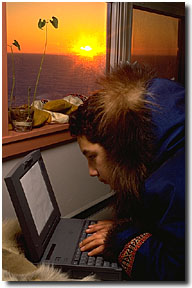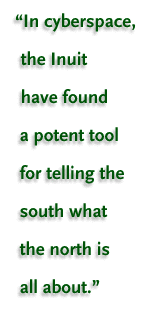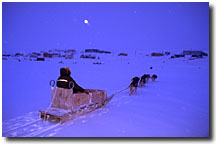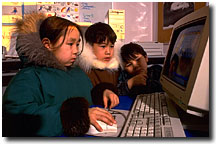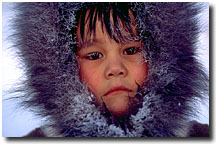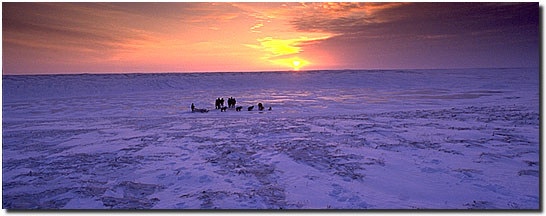|
 he Inuit of Canada's far north endure a life of physical and cultural extremes. Scattered across the Arctic from western Greenland to the eastern tip of Siberia, they still hunt caribou, musk oxen,
seals, and whales to put food on the table. But they also live in conventional housing, watch Seinfeld on
television, and get around on snowmobiles. The collision between old and new has sometimes been disastrous,
contributing to loss of traditions and the unraveling of clans and families. Now, as the Inuit regain control
over ancestral lands, they are embracing computers and the Internet to help strengthen their community and build
economic independence.
he Inuit of Canada's far north endure a life of physical and cultural extremes. Scattered across the Arctic from western Greenland to the eastern tip of Siberia, they still hunt caribou, musk oxen,
seals, and whales to put food on the table. But they also live in conventional housing, watch Seinfeld on
television, and get around on snowmobiles. The collision between old and new has sometimes been disastrous,
contributing to loss of traditions and the unraveling of clans and families. Now, as the Inuit regain control
over ancestral lands, they are embracing computers and the Internet to help strengthen their community and build
economic independence. On February 8th, 1996, Rick Selleck of the Boston-based System Engineering Society was in the
town of Sachs Harbour, population 80, to do some high-tech missionary work. Rick and others, including a couple
mushing up the western shore of Hudson Bay by dogsled, were crisscrossing the Canadian Arctic to drop off NEC
laptop computers, US Robotics modems, and email. They also hope to bring the Inuits the latest wireless
technology, including tiny handheld messaging devices that link to low-flying communications satellites. The
kids of Sachs Harbour impressed Rick. "They've adapted [to computer technology] faster than any kids
we've seen." They love sending messages to friends and families across the north. And with their new digital
cameras, he says, "they can photograph their lifestyle . . . and transmit pictures to other kids all over the
world to show how they live. They're using the Internet the way it should be used." The Inuit plan a more
lucrative use for cyberspace. In 1999, they take control of Nunavut, their name for the 600,000 square miles
north and west of Hudson Bay. They hope to use the Net to cut middlemen out of some of their chief industries, notably tourism and the thriving native crafts trade. As illustrated by services like Nunanet and the
Nunatsiaq Daily News, the Internet also provides a forum for connecting a people spread across an immense
area. A Canadian adage says the Inuit have come from the Stone Age to the Space Age in one generation. In
cyberspace, the Inuit have found a potent tool for building
new cultural bonds and for telling the south what the north is all about .
|





